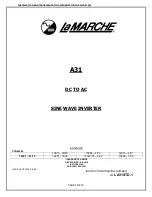
5-14
Data for
F01, C30
Function
2
Enable the current input to terminal [C1] (C1 function) (+4 to +20 mA DC,
maximum frequency obtained at +20 mA DC).
3
Enable the sum of voltage (0 to +10 VDC) and current inputs (+4 to +20 mA DC)
given to terminals [12] and [C1] (C1 function), respectively. See the two items
listed above for the setting range and the value required for maximum
s.
frequencie
Note: If the sum exceeds the maximum frequency (F03), the maximum
frequency will apply.
5
Enable t e v ltage inp
maximum frequency obt
h
o
ut to terminal [C1] (V2 function) (0 to +10 VDC,
ained at 10 VDC).
Enable
UP
and
DOWN
commands
o the digital input terminals.
assigned t
The
UP
command (data = 17) and
DOWN
command (data = 18) should be
assigned to the digital input terminals [X1] to [X5].
7
11
put of the binary coded decimal (BCD) code or binary data
Enable the digital in
entered via the DIO interface card (option).
For details, refer to the DIO Interface Card Instruction Manual.
12
(option).
Enable the pulse train entered via the PG interface card
For details, refer to the PG Interface Card Instruction Manual.
• To in
C) to terminal [12], set function code
C35 to
to +10 VDC and
inter
• Term
function
function
gher priorit
put bipolar analog voltage (0 to
±
10 VD
"0." Setting C35 to "1" enables the voltage range from 0
prets the negative polarity input from 0 to -10 VDC as 0 V.
inal [C1] can be used for current input (C1 function) or voltage input (V2
) depending upon the settings of switch SW7 on the interface PCB and
code E59.
y
• In addition to the frequency command sources described above, hi
i
m
-f
command sources including commun cations link and ulti requency are
provided.
Using the terminal command
Hz2/Hz1
assigned to one of the digital input terminals
E01 to E05.
switches between frequency command 1 (F01) and frequency command 2 (C30).
Refer to function codes
















































